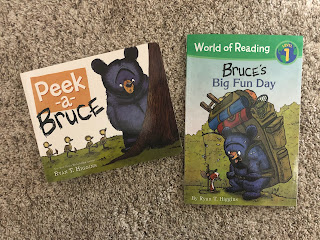I always like to do a camping unit in late summer/early fall. It seems like I often have a lot of families taking camping trips during this time. I usually pair woodland/forest animals with my camping theme, as they are the animals that most of my children would be seeing while camping in the area.
This camping set from learning resources is great for pretend play. We love using it to roast hotdogs and make s’mores. I also pair Speech Room News's S’mores Articulation Activity with the fire. Rather than cutting out and laminating all of those pieces so that they can be attached with Velcro, ice simply glue them directly to the paint stick for the child to take home themselves.
I use my Woodland Animal Sensory Bag Speech activity to target articulation, verb vocabulary, pronouns, verb tenses.
For my kiddos working on language goals, I like to use my Camping Speech And Language Unit. It has worksheets and activities to target grammar vocabulary various concepts, listening comprehension, categories, and so much more! It also includes open ended games that can be used to target any skill.
I also have some random materials that I have accumulated over the years. They are pictured below.
The "All About Camping" mini book is from this push in therapy packet. The picture scene is from this picture chats bundle.
I found these camping pronoun cards that have been a staple in my therapy room for years. I love that they show both genders doing the same activity so that you can use the cards receptively or expressively. I can't find them anywhere now! If you know where they are, let me know so I can add a link! If you are looking for some of your own, there are lots of different options on TpT. Just search "camping pronouns."
This Spot It: Camping game is great for working on camping themed vocabulary. I love to pair it with flashcards or worksheets to target any skill, while incorporating the camping vocabulary/theme.
I use my craft visuals mega pack to make these fun toilet paper tube binoculars during this unit. We decorate them with pictures to target articulation or language goals. I will often print out super Duper articulation pictures at 50% scale to use on them. The kids love it! Then we use the binoculars to look for woodland animals that I’ve hidden around the room. I love this woodland animal set that I found on Amazon. The animals are very realistic looking and many of them are local to our area, so they are animals the child might actually see.
I honestly don’t have a lot of camping themed books, but here are the ones I love to use.
Bruce the Bear Books. My favorites are Peek-a-Bruce and Bruce’s Fun Day. They aren’t specifically a camping theme, but have a lot of the same vocabulary. I really like the Bruce books for perspective taking, social skills, emotions, verbs, describing, spatial concepts, and more.
My son received Home Builders from the Dolly Parton Imagination Library and I immediately wanted it for my therapy room. It talks about all the different houses animals make and how they make them. It’s wonderful for listening comprehension, listening for details, describing, verbs, etc. Birdhouse is very factual and great for listening comprehension, wh questions, listening for details, etc. Riverside Friends is an awesome board book that I love to use with preschoolers.
And I love Squeak for my preverbal friends. It has a ton of environmental noises for them to imitate!
And that will pretty much wrap up my Camping Unit! I hope you found something you could use in your own therapy room! Thanks for stopping by!













